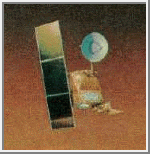













|

NASA Mars Orbiter
Courtesy of NASA's National Space Science Data Center
The Mars Surveyor '98 Orbiter is the companion spacecraft to the Mars Surveyor '98 Lander. The two spacecraft will be launched separately, but comprise a single mission to study the Martian weather, climate, and water and carbon dioxide budget. The mission will help scientists to understand the reservoirs, behavior, and atmospheric role of volatiles and to search for evidence of long-term and episodic climate changes. It will be launched in December 1998.
The orbiter has as its primary science objectives to: 1) monitor the daily weather and atmospheric conditions; 2) record changes on the martian surface due to wind and other atmospheric effects, 3) determine temperature profiles of the atmosphere; and 4) monitor the water vapor and dust content of the atmosphere. The orbiter will use two instruments to carry out these investigations. The Mars Surveyor '98 Orbiter Color Imager (MARCI) will acquire daily atmospheric weather images and high resolution surface images and the Pressure Modulator Infrared Radiometer (PMIRR) will allow measurement of the atmospheric temperature, water vapor abundance, and dust concentration. The orbiter will also serve as a data relay satellite for the Mars '98 Lander and other future NASA and international lander missions to Mars.
The orbiter will use aerobraking in the atmosphere of Mars to achieve a polar orbit about the planet. The orbit will be Sun-synchronous and nearly circular with an altitude of approximately 380 kilometers. The nominal mission is planned for one Martian year (~1.9 Earth years). The instruments are nadir pointing throughout the orbit. The craft is three-axis stabilized, with attitude control and knowledge of 25 mrad, and stability of 1.5 mrad/(1 sec) and 3 mrad/(3 sec).
The Mars Surveyor '98 Orbiter is part of NASA's 10-year Mars Surveyor Program, which will feature launches every 26 months when Earth and Mars are favorably aligned.
Views of the Solar System Copyright © 1997-2000 by Calvin J. Hamilton. All rights reserved. Privacy Statement.